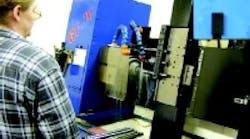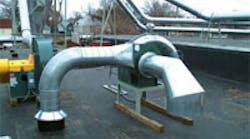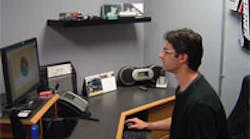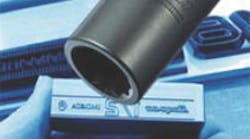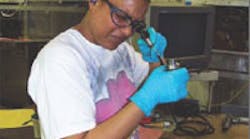Advanced Secondaries accurately produces specials from standard screw-machine and cold-headed parts by drilling, tapping and turning them on a GT-Jr. lathe.
A GT-Jr. lathe at Advanced Secondaries clamps the shop's workpieces in such a way that they come off the machine finished and requiring no secondary operations that could cause tolerance-stackup issues.
Living up to its namesake, Advanced Secondaries, Inc., performs secondary drilling, tapping and turning operations to make specials from standard screw machine or coldheaded parts. A lot of the Cleveland shop's work involves fasteners, and jobs come in one at a time or 70,000 per week. For the most part, these jobs run smoothly, but one in particular raised some quality issues.
Advanced needed to drill and tap holes in 5,000 cold-headed bolts per week, so it fixtured, clamped and drilled them using an automated drill head. However, since parts remained stationary while drills turned, the setup produced runout, and operators had to physically make sure parts were in the right position for countersinking prior to tapping. To remedy the situation, Advanced purchased an OmniTurn GT-Jr. lathe manufactured by Richlin Machinery Inc. in Farmingdale, N.Y.
The GT-Jr. gang-tool-style lathe handles up to eight tools, and with special tooling, its operations increase to over eight. Axis travels measure 12 in. in X and 9 in. in Y, and the machine's 5-hp spindle turns at 4,000 rpm (6,000 rpm optional). The machine rapids and feeds at 300 ipm riding on precision linear guides and ground, zero-backlash ballscrews. Its frame is an MJ7 composite casting with a cast iron headstock.
A PC-based CNC includes special software that provides easy programming using industry-standard G codes. The control features graphical toolpath verification and a wordprocessor program editor.
"Although the controller is not conversational," says Advanced owner Don Nicholson, "it offers canned program cycles and interfaces with programming software such as Mastercam and Partmaker." The shop can program offline on a PC and download with a disk or through an ethernet.
Barfeeders easily adapt to the GT-Jr., which requires no special foundation because of its sturdy frame. A 4-in.-thick garage floor is sufficient.
Nicholson adds that the machine's gang-style tooling is well-suited for his shop's work and it accommodates numerous tools that are easily changed out. Also, the machine is not overly complex because it doesn't have a turret or toolchanger and the maintenance that those systems involve.
For the bolt job, the GT-Jr. does not improve actual part cycle times, but it clamps parts in such a way that they come out of the machine finished and requiring no secondary operations that could cause tolerance-stackup issues. "The machine provides TIRs of 0.001 to 0.003 in., which is quite good considering the bolts are cold headed," comments Nicholson.
Using drill heads, the shop often stationed a setup man at the machine to re-center the fixture and drill head after a crash or tool break. If a drill breaks on the GT-Jr., the shop replaces it and gets back to producing parts.
Nicholson was so pleased with the GT-Jr.'s performance, he purchased three more, two of which are in a cell tended by one operator. www.omni-turn.com
